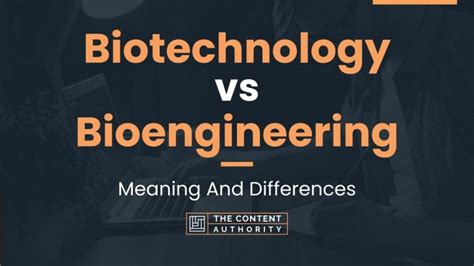In today’s rapidly evolving technological landscape, bioengineering and biotechnology have emerged as two intertwined yet distinct fields that play a pivotal role in shaping the future of healthcare, agriculture, and beyond. While both disciplines share a common foundation in biology, they diverge in their specific approaches and applications.

Anatomy of Bioengineering: The Fusion of Biology and Engineering
Definition: Bioengineering, also known as biomedical engineering, seamlessly integrates engineering principles with biological knowledge and systems. It leverages engineering tools and techniques to understand and manipulate living organisms, medical devices, and biological processes.
Key Applications:
- Medical Devices: Designing and developing artificial organs, prosthetics, and diagnostic tools for improved patient outcomes.
- Tissue Engineering: Creating biological substitutes to repair or replace damaged tissues and organs.
- Bioinformatics: Analyzing and interpreting biological data to identify disease patterns, drug targets, and personalized treatments.
- Synthetic Biology: Engineering biological systems to create new biological functions or modify existing ones.
Biotechnology: Harnessing Biology’s Potential
Definition: Biotechnology encompasses a broad spectrum of technologies and scientific techniques that utilize biological systems, living organisms, or their components to develop products or processes. It focuses on manipulating genes, cells, or tissues to create new solutions for various industries.
Key Applications:
- Pharmaceuticals: Developing new drugs, vaccines, and therapies for a wide range of diseases.
- Agriculture: Enhancing crop yield, disease resistance, and nutritional value through genetic modification.
- Industrial Biotechnology: Creating bio-based materials, enzymes, and fuels to replace fossil-fuel-based products.
- Environmental Biotechnology: Utilizing microorganisms to clean up pollution, remediate contaminated sites, and produce biofuels.
Comparative Overview: Unraveling the Differences
| Feature | Bioengineering | Biotechnology |
|---|---|---|
| Focus | Engineering principles applied to biology | Using biological systems for various applications |
| Scope | Medical devices, tissue engineering, bioinformatics | Pharmaceuticals, agriculture, industrial biotechnology |
| Methodology | Design and development of medical technologies | Modification of biological systems |
| Primary Objective | Improve medical treatments and devices | Create new biological products and processes |
Pain Points and Motivations
Bioengineering:
- Pain Points: High costs of medical devices, ethical concerns about synthetic biology, and the need for personalized treatments.
- Motivations: Improve patient outcomes, create safer and more effective treatments, and advance medical technology.
Biotechnology:
- Pain Points: Genetically modified organism (GMO) controversies, regulatory challenges, and the ethical implications of using biological systems.
- Motivations: Address global challenges such as disease outbreaks, food security, and climate change, and improve the sustainability of various industries.
Common Mistakes to Avoid
- Bioengineering: Overreliance on engineering principles without adequately considering biological complexity and safety concerns.
- Biotechnology: Oversimplifying biological systems and underestimating the potential risks and unintended consequences of genetic engineering.
Why Bioengineering and Biotechnology Matter
The convergence of bioengineering and biotechnology holds immense promise for addressing pressing global challenges:
- Medical Advancements: Bioengineering has revolutionized healthcare by developing innovative devices, treatments, and diagnostic tools that improve the quality of life and extend human lifespans.
- Food Security: Biotechnology has played a significant role in increasing crop yields and reducing food shortages, helping feed a growing population.
- Environmental Sustainability: Bioengineered microorganisms and enzymes offer eco-friendly solutions for waste management, pollution reduction, and biofuel production.
- Biopharmaceutical Innovations: The combined efforts of bioengineering and biotechnology have led to the development of personalized medicine, cutting-edge cancer therapies, and the potential for tissue regeneration.
Benefits of Collaboration
Collaboration between bioengineering and biotechnology can accelerate scientific breakthroughs and drive innovation:
- Enhanced Medical Devices: Bioengineers can utilize insights from biotechnology to design medical devices that are more biocompatible and tailored to individual patient needs.
- Precision Medicine: Biotechnology provides genetic information that bioengineers can use to develop personalized treatments and optimize device performance.
- Biomanufacturing: Combining bioengineering and biotechnology enables the efficient and scalable production of biological products, such as vaccines and therapeutic proteins.
- Biologically Inspired Innovations: Bioengineers can draw inspiration from biological systems to create novel materials, energy devices, and other technologies.
Emerging Innovations: Inventing the Future
The fusion of bioengineering and biotechnology is spawning a myriad of exciting new applications:
- Biofabrication: 3D printing of living cells and tissues for regenerative medicine and organ transplantation.
- Organ-on-a-Chip: Miniaturized devices that mimic human organs, enabling drug testing and disease modeling.
- Biosensors: Wearable or implantable devices that monitor biological signals and provide real-time health data.
- Bio-Inspired Robotics: Robots that mimic movements and functions of biological organisms for enhanced dexterity and performance.
Conclusion
Bioengineering and biotechnology are two dynamic fields that are fundamentally transforming the world as we know it. By combining the principles of engineering and biology, they have the potential to solve complex challenges, improve human health, and create a more sustainable future. As these fields continue to evolve, their collaborative efforts will undoubtedly lead to groundbreaking innovations that shape the next chapter of human existence.
